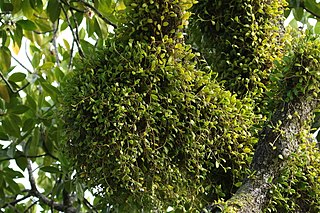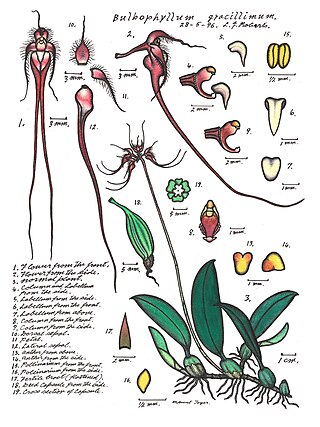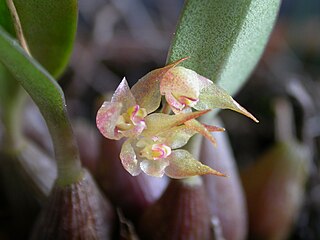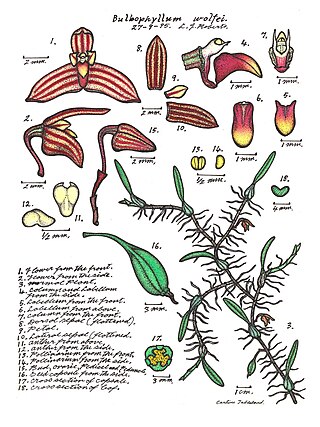
Orchids are plants that belong to the family Orchidaceae, a diverse and widespread group of flowering plants with blooms that are often colourful and fragrant. Orchids are cosmopolitan plants that are found in almost every habitat on Earth except glaciers. The world's richest diversity of orchid genera and species is found in the tropics.

Bulbophyllum is a genus of mostly epiphytic and lithophytic orchids in the family Orchidaceae. It is the largest genus in the orchid family and one of the largest genera of flowering plants with more than 2,000 species, exceeded in number only by Astragalus. These orchids are found in diverse habitats throughout most of the warmer parts of the world including Africa, southern Asia, Latin America, the West Indies, and various islands in the Indian and Pacific Oceans. Orchids in this genus have thread-like or fibrous roots that creep over the surface of trees or rocks or hang from branches. The stem is divided into a rhizome and a pseudobulb, a feature that distinguished this genus from Dendrobium. There is usually only a single leaf at the top of the pseudobulb and from one to many flowers are arranged along an unbranched flowering stem that arises from the base of the pseudobulb. Several attempts have been made to separate Bulbophyllum into smaller genera, but most have not been accepted by the World Checklist of Selected Plant Families.

Bulbophyllum fletcherianum, the tongue orchid, Fletcher's bulbophyllum or Spies' bulbophyllum, is a rare orchid native to southern New Guinea. It prefers sunny rock outcrops or mossy tree branches, but besides being lithophytic or epiphytic, it can also be pseudo-terrestrial. The tongue orchid requires high humidity and moist roots.

Bulbophyllum biflorum is a species of orchid. This species was found in Java, Sumatra, Bali, Borneo, the Philippines, and the Thai and Malaysian peninsula. The flower size is 7.5 cm long.
Bulbophyllum abbrevilabium, also known as the short-lipped bulbophyllum, is a warm-growing species of orchid in the genus Bulbophyllum. It is found in the Southeast Asian countries Thailand, Malaysia and Vietnam. It bears a flower about eight millimetres wide. Akin to the majority of orchid species, it is a pseudobulb epiphyte, and is typically found hanging from tree branches.

Bulbophyllum ankylochele is a species of orchid in the genus Bulbophyllum. This orchid species is native to the New Guinea and is known for its small size and beautiful, intricate flowers. The scientific name "ankylochele" comes from the Greek words "ankylos," meaning "bent," and "cheilos," meaning "lip," referring to the lip of the flower that is bent downwards.

Bulbophyllum annandalei or Annandale's Bulbophyllum is a species of orchid in the genus Bulbophyllum in section Cirrhopetalum.

Bulbophyllum apodum is a species of orchid in the genus Bulbophyllum. It bears a 12–14 cm inflorescence with around 40 small fragrant white flowers on it. It is native to Sikkim, Borneo, China, Malaysia, Thailand, the Philippines, Vanuatu, and Vietnam.

Bulbophyllum clandestinum is a species of orchid in the genus Bulbophyllum. This orchid grows long hanging rhizomes from which it produces tiny pseudobulbs that each bear one leaf. Flowers are born on each node, they are 3–5 cm in length and are a creamy colour. It is native to Borneo, Laos, Malaysia, Myanmar, Thailand, the Philippines, and Vietnam.

Bulbophyllum exiguum, commonly known as the tiny strand orchid, is a species of epiphytic or lithophytic orchid that is endemic to eastern Australia. It has small, roughly spherical pseudobulbs each with a single leaf and up to three small creamy white to yellow flowers emerging from the base of the pseudobulb. This orchid grows in rainforest and dry forest where it often covers the branches of trees or rocks on which it grows.

Bulbophyllum lepidum, is a species of orchid, in the subfamily Epidendroideae and the genus Bulbophyllum, with the common name: Venus' fan bulbophyllum.

Bulbophyllum gracillimum, commonly known as the wispy umbrella orchid, is a species of epiphytic orchid. It has a creeping rhizome, widely spaced, olive green pseudobulbs, each with a single thick, leathery, fleshy leaf and between six and ten purplish red flowers spreading in a semicircular umbel. The flowers have distinctive long, thread-like tails on the lateral sepals. It has a wide distribution and is found in New Guinea, New Caledonia, Indonesia, Malaysia and part of tropical North Queensland.

Bulbophyllum longiflorum, commonly known as the pale umbrella orchid, is a species of epiphytic or lithophytic orchid. It has a creeping rhizome, widely spaced, dark green pseudobulbs with a single large, fleshy leaf, and flowers spreading in a semicircular umbel, resembling one-half of an umbrella. The flowers are canoe-shaped, greenish cream-coloured to yellowish with purple dots. It has a wide distribution and is found in parts of Africa, on islands in the Indian and Pacific Oceans, Southeast Asia, New Guinea and northern Australia.

Bulbophyllum purpurascens is a species of orchid in the genus Bulbophyllum in section Cirrhopetalum. Not the most showy of orchids, this orchid bears 10 to 12 flowers on each of its inflorescences. The flowers are pale yellow and are about 1.5 cm long. It is native to Borneo, Indonesia, Malaysia, and Thailand.
Bulbophyllum rufilabrum is a species of orchid in the genus Bulbophyllum. Its common name is 'The Fox Red Lip Bulbophyllum.' The Bulbophyllum rufilabrum flowers in October and November in the Indo-China region. The flower is 0.3 cm wide and 0.5 cm high. It is made up of three peddles, the outer two forming an open pod shape with a third, red peddle, in the center. The blooms form clusters on the end of the orchid's spikes (stems).

Bulbophyllum scabratum or Rough Bulb-Leaf Orchid is a species of orchid in the genus Bulbophyllum in section Eublepharon.

Bulbophyllum wolfei, commonly known as the fleshy snake orchid, is a species of epiphytic or lithophytic orchid with thin, creeping rhizomes, and flattened pseudobulbs each with a single thick, fleshy, dark green leaf and a single cream-coloured flower with dark red stripes. It mostly grows on rainforest trees in tropical North Queensland.
Bulbophyllum nocturnum is a species of epiphytic orchid that grows in New Britain. It was described in 2011, and is the first species of orchid known to consistently flower during the night, and close its flowers during the day.

Dendrobieae is a tribe in the subfamily Epidendroideae, in the family Orchidaceae. The Dendrobieae are mostly tropical, epiphytic orchids which contain pseudobulbs.
An attractant is any chemical that attracts an organism, e.g. i) synthetic lures; ii) aggregation and sex pheromones ; and iii) synomone















